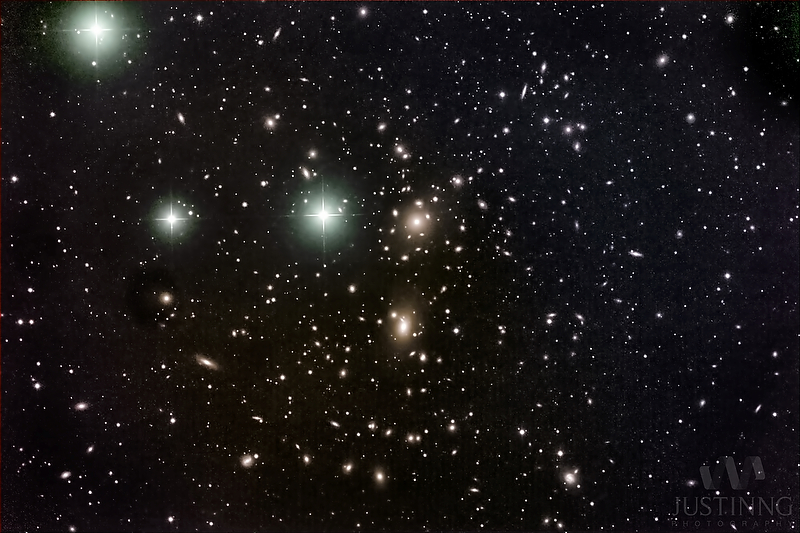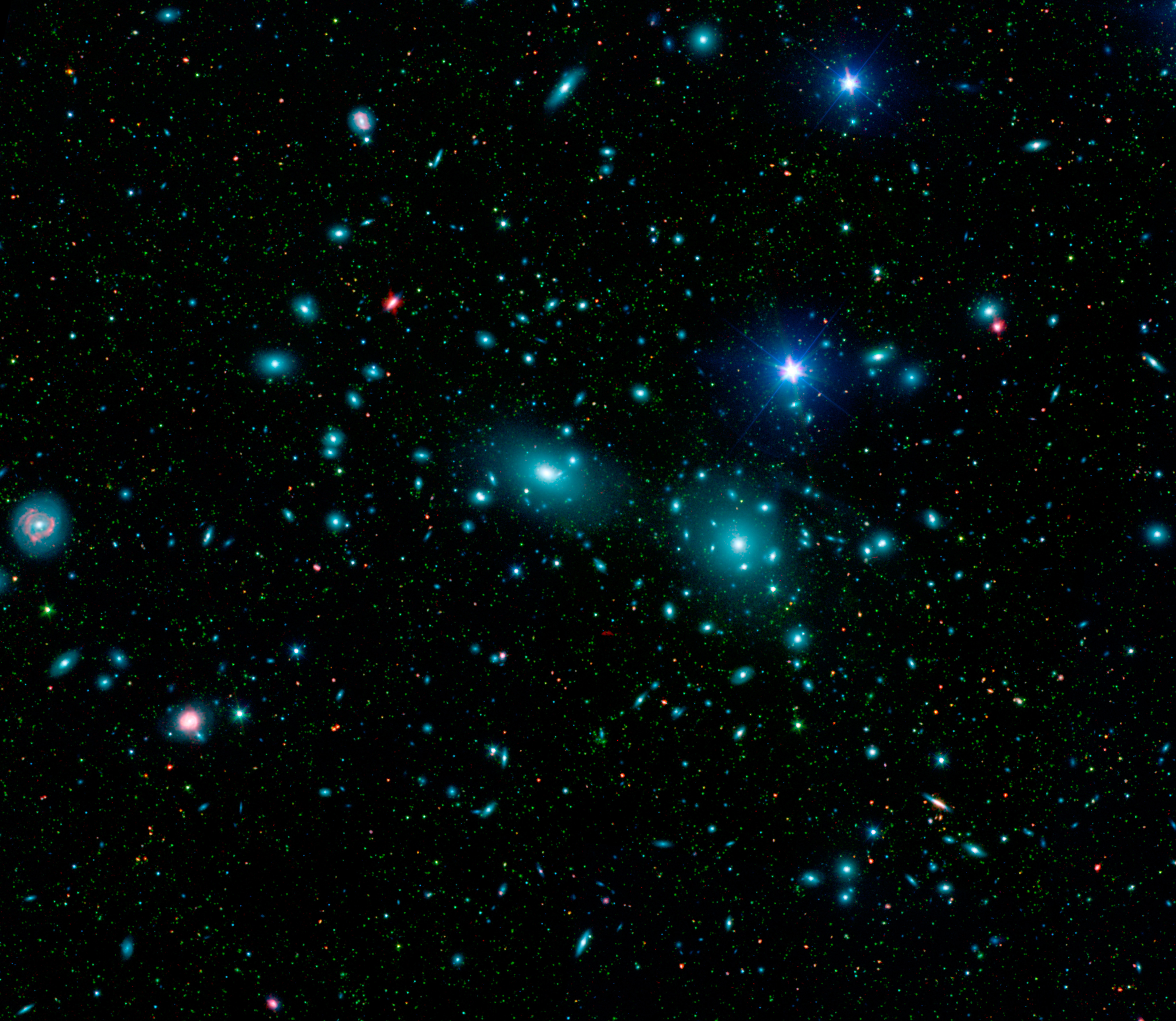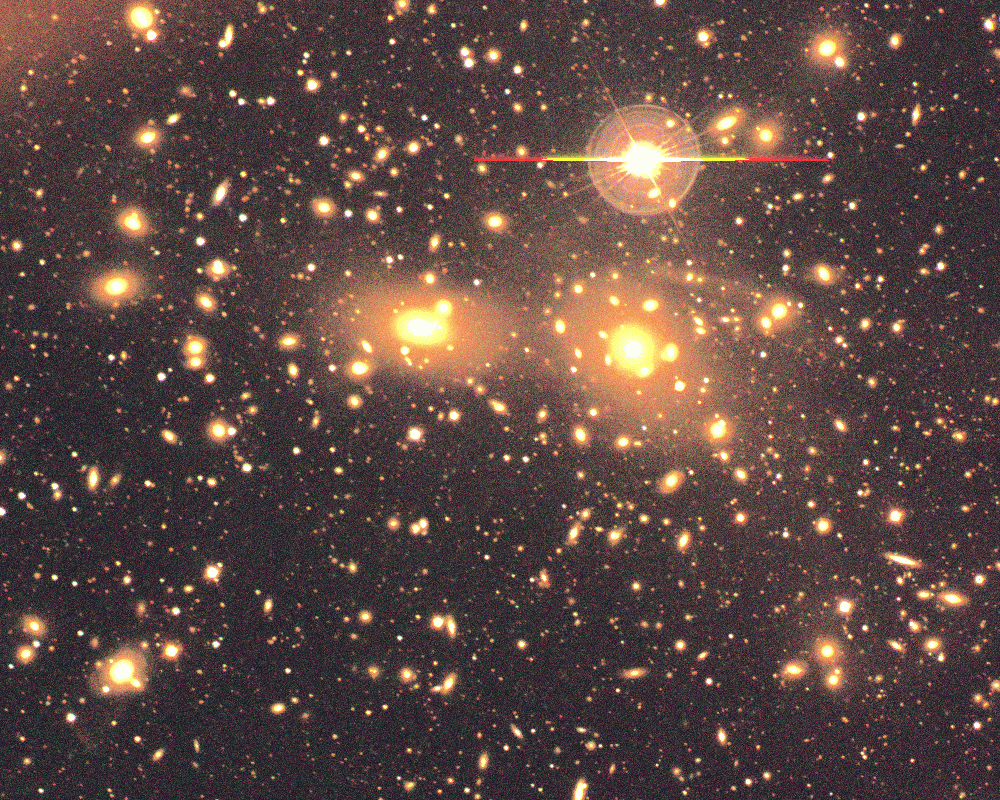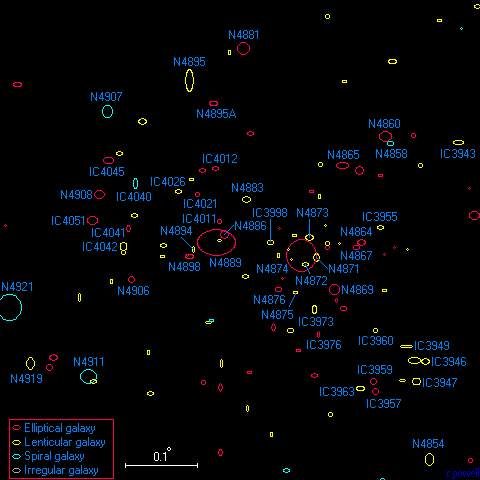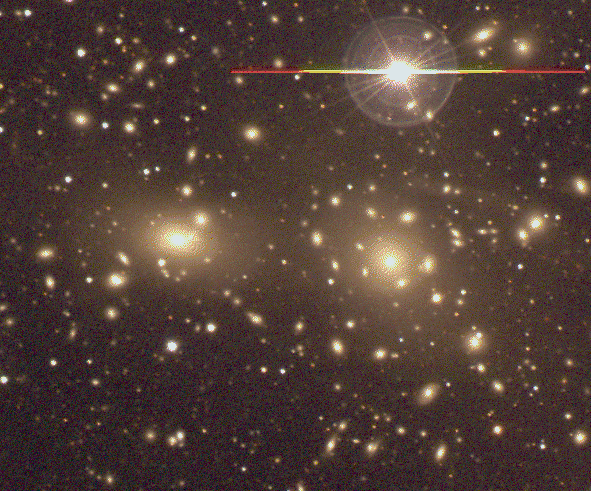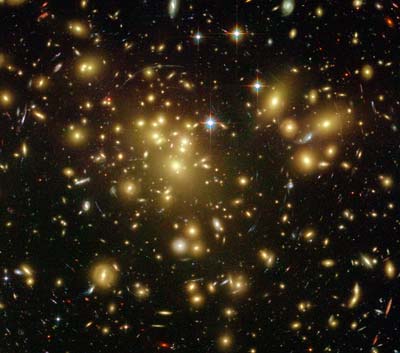Coma Cluster
The Coma Cluster of Galaxies is a huge collection of over 1000 galaxies in the constellation Coma Berenices (Latin Coma Berenices ) occupy an angle of about 5 °. He has played a major role by its relative proximity to the study of the large-scale distribution of galaxies and is in accordance with the well-known astronomer George Abell Ogden also known as Abell 1656.
The central area is 2 ° in size and, away, assuming a Hubble constant of H = 70 km / s / Mpc, about 100 megaparsecs from the sun. However Unsöld indicates 130 Mpc ( 400 million light years). The diameter of the Coma cluster of galaxies is about 20 million light-years.
Arrangement of galaxies
The galaxies are not uniformly distributed in space, but can be grouped into higher-level clusters. Cosmologists assume that these structures have already formed in the early universe from a large scale foam-like mass distribution under the influence of gravity.
Large pile have several thousand individual galaxies, which rotate in different orbits with 500 to 1000 km / s the focus of the system. They are spread over an area with a diameter of about 3-5 Mpc. The total mass is 1014-1015 solar masses. In the center there is usually a particularly large elliptical galaxy.
In contrast, field galaxies (see galaxy clusters ) of which can be found in the constellation Coma some, due to only small density fluctuations in the primordial universe.
The constellation Coma has to offer both versions. Due to its location near the galactic north pole, this viewing direction - perpendicular to the plane of the Milky Way - hardly affected by the gas and dust clouds of the plane. Therefore, some foreground galaxies at distances of 20 to 40 million light- years ( MLJ ) are easily observed, behind which an extension of the Virgo Cluster (50-70 MLJ ) stands, as well as the actual Coma cluster of galaxies in 300-450 MLJ distance. Beyond these clusters can be identified with large instruments or the Hubble Space Telescope more distant galaxies structures. Overall, the Palomar Sky Survey shows in question 3 ° section of the constellation Coma nearly 7000 galaxies ( see 4 web link) to about the size limit 21mag, which extends far beyond the Comahaufen.
Besides the two mentioned clusters of galaxies have been studied in the past decades, numerous smaller groups in other sky regions, including the M81 and the Sculptor Group. The more distant structures and the so-called superclusters are only beginning to be elucidated with modern large - and space-based telescopes, such as in the direction of the constellations Centaur, Great Bear (Ursa major), Hercules, Perseus / Pisces and Hydra (see links). In their extremely long exposure deep sky shots finally finds a myriad most distant background galaxies, including those distorted by the action of gravitational lenses into arcs appear.
Discovery history of the Coma cluster
Some brighter spiral nebulae of the Coma cluster of galaxies are already apparent in larger amateur telescopes, such as NGC 4889 with 11.5 m. But the fact that he has over 1000 galaxies, it became clear only in recent decades.
The brightest 100 " nebulae " of heaven were cataloged about 1760-1780, especially from the comet researcher Charles Messier. Among them were several nearby galaxies in the constellations of Coma and Virgo ( the Virgin ), but far ahead of the Comahaufen: the Black Eye Galaxy Messier 64 M49 and M87 in Coma and in the neighboring Virgin. In this constellation, Messier was in 1781 a cluster of galaxies, and the Messier catalog in 1784 already contained 16 objects of Virgohaufens, but one recognized his true nature until much later. From seven times more distant Coma cluster initially nothing was visible, only the galaxies mentioned in his fore.
William Herschel sighted from 1783 in some distant nebulae and had been measured to 1785 23 galaxies of the Comahaufens. He noted that they are not randomly distributed, but seem to cluster in some directions. His son John Herschel observed the area 1827-1831, but found no specific accumulation, because most of the galaxies were at the limit of visibility.
Only Heinrich Louis d'Arrest recognized in the accumulation of these distant nebulae by systematically scale observations in the years 1861-1867 the galaxy clusters. Although his refractor had only 11 inches aperture, but a low-priced field. Soon, more fog were discovered in Comahaufen, of which 12 by Guillaume Bigourdan 1885-1895 and 22 from Hermann Kobold. Often falsely Max Wolf (1864-1932) is known as the discoverer; by him, however, comes the first successful photograph of the cluster ( March 1901 ) and an analysis based on it ( see figure below).
The structure of the Coma cluster
While some spiral nebulae located in the foreground about as bright as 10 mag have and are already visible in small amateur telescopes that require the brightest galaxies in the Coma cluster itself (13-14 mag) already telescopes of at least 20 cm opening. To further determine the cluster galaxies without a more detailed analysis, it also needs a good wide angle or a series of photographs of very uniform quality. The immense richness of the cluster was therefore not recognized until relatively late.
Its center is set approximately at the following coordinates:
The mean redshift of his group members is 0.0219 ( 0.0232 according to other sources ), what / s corresponds to a radial velocity of 6600-7000 km.
Near the geographic center is NGC 4889, a giant elliptical galaxy, and, unusually, a second, namely NGC 4874th Both are of the type of cD galaxies and from us over 300 MLJ, mutually but only 1 MLJ. Most of the other star systems in the central region have elliptical shape, suggesting it is very old and the fusion of numerous individual galaxies. In the less massive outer regions, however, prevail spiral galaxies in their spiral arms regions continued star formation are found.
The Coma cluster is - as well as other comparable systems - imbued with a thin intergalactic gas, which can become very hot due to the rapid movement of the pile associated galaxies around the central region. It thus achieved temperatures of several million degrees and is noticeable by the first time in 1971 demonstrated emission intense X-ray radiation. A particularly extensive X-ray source of the heap is called Coma X-1. In addition, however, most of the mass must be so-called dark matter. You can not be observed directly, but determined only by the effect of their gravity.
Numerous radio sources were located here in a field of 2x2 °: one summarizes 13 detailed analyzes of the frequency ranges 150 kHz to 4.8 GHz together, there are 298 radio sources, of which half ( with a radiation above 10 m Jansky ) also examined spectrally.
Among the visible in a 50cm telescope objects include:
- NGC 4860, 4864, 4867, 4869, 4871, 4873, 4874, 4875, 4876, 4883, 4886, 4889, 4894, 4898, 4906, 4908, 4927, 4929, 4931 and 4934;
- IC 3946, 3947, 3949, 3957, 3959, 3960, 3963, 3973, 3998, 4011, 4021, 4026, 4041, 4042, 4051, and PGC 44652nd
Typing and Coma Supercluster
In the modern typing of galaxy clusters by Rood and Sastry (C = nuclear, B = binary, F = flat, L = linear, I = irregular ) is one of the Coma cluster to the B- heap: he is of a pair of cD galaxies dominated, as the astronomer George Abell of the famous observatory Mount Palomar found out in the 1950s. In his fundamental catalog it is called Abell 1656.
The whole pile is nearly spherical but has smaller arm in some degree angular interval. The numerous elliptic (older) galaxies are concentrated toward the center where the two oe cD galaxies are (see figure above and Palomar - field recording in the 1st web link). The average distance between two galaxies is there only one-third of the distance between our Milky Way and the Andromeda Galaxy. The Coma cluster is an example of a very rich clusters of galaxies. The galaxies are for many billions of years together in gravitational interaction and their kinetic energies aligned in this way today.
In a little less distance, and in the other direction as the Coma cluster, a similar accumulation was discovered, called the Leo cluster of galaxies ( Abell 1367 ). He belongs to the type F (flat, ie with strong flattening ) MLJ 290 is removed and, together with Abell 1656 a part of the Coma supercluster. The two clusters ( Coma and Leo ) are connected by a "bridge" of galaxies, and possibly also in our direction.
The sky adjacent even more Virgo cluster of galaxies, however, is six times closer and has a more irregular shape. He is grouped with several other structures as the Virgo Supercluster, which also includes our Milky Way and the Local Group. Many galaxies researchers suggest these two major structures as coherently and speak of the Coma- Virgo Supercluster or of a long filament: The Virgo spiral filament is probably part of a very long filament did runs from Virgo way back to the " Great Wall " at the distance of the Coma cluster ( Hoffman et al.1995 ), and it might also even be connected, on the nearside, with the " Coma- Sculptor cloud " that runs through, ie includes the Local Group. If so, we Should not be surprised to observe a ' finger of God ' - Because we live in a finger of God ..

